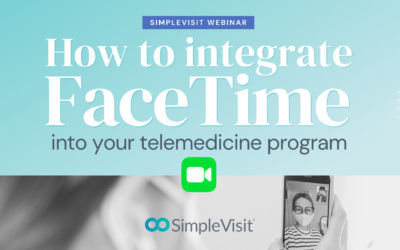
5 Rules for Healthcare Virtual Visits
As payers and technology continue to develop in support of the rising trend of telemedicine, it is important for providers to understand the basic rules of practicing in the virtual world. Below are the five guidelines for healthcare providers offering video visits.
1. Provider Licensing
Licensure is often seen as one of the biggest barriers to the establishment or growth of a telemedicine program. Despite technology’s ability to connect patients and providers almost anywhere in the world, it is not universally permissable to do so. When practicing telemedicine, it is critical providers only see patients who are located in the states in which they are licensed to practice. This means when your patient is doing a cross-country road trip, you can not conduct a visit with them via video call as a provider. Legislation is currently transforming how licensing is conducted on a state-by-state level, however at the time of this writing, providers cannot practice across state lines where they are not licensed. More information pertaining to state regulations can be found at http://www.americantelemed.org/policy/state-policy-resource-center.
2. Prescribing Medication
When prescribing medication to patients over a video visit there must be “a legitimate medical purpose in the usual course of professional practice to prescribe,” meaning the doctor must have conducted at least one medical evaluation prior to the prescription. Much controversy now surrounds what qualifies as a medical evaluation. Some states require the first interaction where this evaluation would occur to be an in-person visit, while others accept a virtual evaluation via telemedicine. To be safe, providers that are implementing a video visit solution should only prescribe to patients they already have an existing relationship with. Powerful narcotics have been a major point of contention when it comes to telemedicine and it is recommended that they should only be prescribed under physician supervision. Discretion should be shown when attempting to prescribe these type of pharmaceuticals over telemedicine.
3. Billing
Billing is a shifting landscape for telemedicine. Over half of the states currently enforce parity law, which require private insurers to reimburse video visits just as they would in-person visits. However, it does not require them to pay at the same rate. For example, Empire Blue Cross Blue Shield reimburses video visits at half of the rate as an in-person visit. As long as the visit is done over a synchronous audio and video channel, providers typically use the same CPT code for billing as they would with an in-person visit. Some insurers may require modifiers to the code to identify the type of care as a telemedicine visit, but they cannot by law decline a claim on the basis of the instance being performed via telemedicine. The Telehealth Resource Center (http://www.telehealthresourcecenter.org) provides tools for providers for each geographical region regarding Medicaid, regulations, and reimbursement qualifications for telemedicine practices.
4. Patient Consent
It is important that patients be made aware that telemedicine visits are a supplement to on-site treatment and can be used as a means to improve access to care that may be limited by location or provider availability. Providers should clearly acknowledge that virtual visits, while a replacement of a physical visit, will be billed to their insurance as if they had come into the office. It is suggested for providers to verify consent of these terms prior to scheduling or conducting a video visit.
5. Eligible Technologies
The Omnibus Rule of 2013 went a long way in defining qualifications of a “Business Associate” and HIPAA compliance regarding telemedicine. Under this provision, a telecommunications conduit is any software that uses end-to-end encryption while restricting session data storage and decryption of live sessions. This means programs such as Microsoft Skype, Apple FaceTime, and Google Hangouts may all be used for patient communications without the software companies signing a Business Associates Agreement (BAA). The relationship is similar to Verizon. as a telecommunications carrier, can facilitate phone calls to patients without becoming a business associate. By understanding these guidelines, providers are taking the first steps to be prepared to offer HIPAA compliant video visits.
About SimpleVisit
SimpleVisit is a video service which allows patients and providers to connect over the video platform of their choice. With SimpleVisit providers are able to deliver on-demand visits to patients over any device or platform they have available to them. For more information on SimpleVisit and on how we are enabling providers to host virtual visits check out www.SimpleVisit.com
How to Integrate FaceTime for Telemedicine
Rob Warlick | 3 min read | April 23, 2021During the public health emergency, direct FaceTime calls are permitted for healthcare. Outside of that waiver, SimpleVisit is the only HIPAA-compliant way to bridge in FaceTime and other video calling apps. With over 620...
Using FaceTime for Telemedicine in 2021
Rob Warlick | 4 min read | January 26, 2021 In response to the global pandemic and the public health emergency, many medical groups have purchased or crafted a solution to treat over video. Due to the lax in federal regulations, many are turning to commonly available...
Kindness and Healthcare
Allie Clark | 10 min read | December 2, 2020It is time for some kindness. The holiday season can be a rough time for many among us. A report from the National Alliance on Mental Illness shows that this time of the year negatively affects a majority of people suffering...



